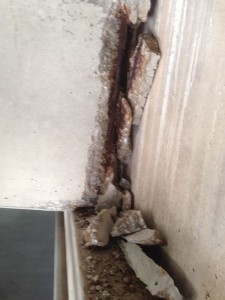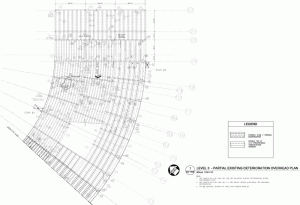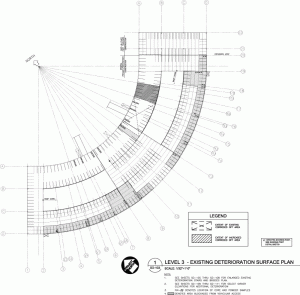Part 5: The Follow-up
This article is a continuation of a previous four-part series entitled The Triage, Life Support and Subsequent Euthanasia of an Existing Precast Parking Garage. Part 4 appeared in the April 2014 issue of STRUCTURE magazine. Pennoni conducted a follow-up structural condition assessment a little more than one year after the original investigation, which was completed in December 2012. The Owner requested the additional evaluation due to a delay in the implementation of the previously recommended temporary repairs and concern about the ongoing deterioration of the garage.
Observations
Pennoni observed a few minor additional conditions that related primarily to damage inflicted by snow removal equipment, and also noted an increase in previously observed deterioration, including:
- The deterioration of the precast, prestressed inverted “T” girders had increased approximately 68% for cracks and approximately 34% at spalls. Cracks and spalls (including subsurface delaminations) were quantified by measured length and area, respectively, during both the original and follow-up assessments.
- The deterioration of the double-tee channel slabs had increased approximately 5% for cracks and approximately 9% at spalls.
- Several parking spaces on the second level had been closed off since the original investigation, typically below existing third-level girders or double tees that were exhibiting increased deterioration.
More significant and severe accelerated deterioration was observed at two specific areas of the garage, including:
Level 3 Existing Barricaded Area – At a portion of the third or top level, which had been previously closed off, additional deterioration was evident at the girders located at the perimeter of the barricaded area. At one of the perimeter girders, the exposed prestressing strands had additional section loss, with six strands exhibiting a total or nearly complete loss of cross-sectional area.
Level 3 Precast Double Tees – The 24-inch-deep precast double tees experienced an increase in deterioration of approximately 2% for cracks and 11% at spalls. During the original investigation, cracking and efflorescence was concentrated in the double-tee flanges in the area of the garage closest to the southern or outer arc of the facility. During the follow-up investigation, it was observed that the cracks in the flanges had migrated down into the stems of the double tees, almost exclusively at the end bearings. The new cracking was severe enough to create large spalls, exposing the embedded reinforcing of the double-tee stem (Figure 1). The exposed reinforcing, which appeared to be associated with the embedded bearing plate assembly, exhibited significant corrosion. Where the cracking was not severe enough to result in spalling of the concrete, the cracks exhibited corrosion by-product (rust) stains, which indicated subsurface deterioration of the internal reinforcing.
Analysis of Accelerated Deterioration
Barricaded Area
The percentage increase in cracks and spalls observed at the precast double-tee channel slabs and girders was consistent with the 2- to 3-year remaining service life, in the absence of any repairs that the original 2012 Pennoni report predicted. However, the increased deterioration of the girders on the third level at the area closed to parking was a concern. The two perimeter girders were positioned directly below the bollard barricades. Therefore, live loads could still be imposed on these structural members, because parking was allowed in the adjacent tributary areas supported by the same girders. A review of the existing shop drawings for the girders indicated that the member that exhibited the worst reinforcing corrosion was constructed with seventeen ½-inch-diameter prestressing strands. Therefore, based on the observed loss of six strands, the reduction in the capacity of the girder would be approximately 35%.
The imposed loads on the third-level girders are 100 pounds per square foot (psf) of dead load and 40 psf of live load. A 35% reduction of the total load on the girder was required to offset the observed loss of prestressed reinforcement due to corrosion. Therefore, all of the 40-psf live load – which corresponds to 29% of the total service load and 35% of the total factored load – needed to be removed from the girder. As a result of this critical situation, Pennoni notified the Owner of the condition immediately after the condition assessment and recommended that the areas closed to parking on the third level be increased so that no live loads could be imposed on the referenced perimeter girders at the original barricaded area (see Figure 2).
Precast Double Tees
The rapid deterioration of the precast double tees observed at the third level on the outside arc of the garage occurred as a result of three primary factors. First, as indicated in the 2012 Report, the water-soluble chloride content by weight of cement in the double-tee flanges exceeded the ACI recommended limit for precast concrete. Therefore, any internal embedded reinforcement in the double tees would be more susceptible to corrosion.
Second, the affected double tees were located at the outside arc of the garage at the low point of the sloped third level, such that precipitation – including road salts brought in by vehicles – collected in this area. Even though no deicing salts were directly applied to the upper level of the garage, this resulted in a concentration of the contaminated drainage runoff on the surface of deck above the deteriorated double-tee stems. At these same locations, failures and gaps in the sealant used at the joint between the ends of the double tees and support girders, as documented in the 2012 Report, allowed the collected moisture and road salts to penetrate down into the same area of the double-tee stem ends that were exhibiting the worst deterioration.
Third, the 2013-2014 winter weather, which included record-breaking snowfall and an increased frequency and magnitude of freeze-thaw cycles, had also contributed to the accelerated deterioration of the double-tee stem ends. This is because the cracks there were susceptible to damage from freeze-thaw cycles. The damaged cracks allowed for the infiltration of the contaminated moisture into the embedded stem-end bearing assembly reinforcement, which then resulted in corrosion of the steel.
The level and severity of the corrosion, spalls and damaged concrete at the stem ends of the double tees indicated that the structural integrity of the bearing conditions had more than likely been compromised at a number of locations. This was of particular concern because there was very little (if any) redundancy available in the existing bearing assembly; therefore, the failure of this portion of the member would be non-ductile (i.e., without warning), which would result in a third-level double tee suddenly and catastrophically collapsing onto the next lower level. This dynamic impact would more than likely also cause, in turn, the collapse of the second-level double tee immediately below. Pennoni notified the Owner of this unsafe condition immediately after the condition assessment and recommended that several of the double tees be shored. Subsequent conversations with the Owner determined that the recommended shoring could not be installed immediately due to extended lead times involved with retaining a shoring contractor, leading to the decision that the affected areas should be immediately closed from use (Figure 3).
Conclusions
The original 2012 Pennoni report concluded that the repair of the garage was neither practical nor technically feasible because of the lack of available long-term methods of repair for the prestressed girder reinforcing in the presence of high chloride content, and that the garage should therefore be demolished and replaced. However, to extend the life of the garage to provide adequate time to design and construct a replacement garage, the report recommended that the girders be temporarily repaired with a passive galvanic system and permanently shored, and that yearly inspections of the garage be conducted.
As a result of the accelerated deterioration that occurred between the end of 2012 and the start of 2014, Pennoni recommended instead that regularly scheduled monthly condition assessments be conducted at the garage, and that the repair work associated with the previous report be initiated within the next year. This approach, in conjunction with the 2014 emergency remediation measures, will ensure that the facility remains partially usable and safe until the new garage can be constructed.▪



